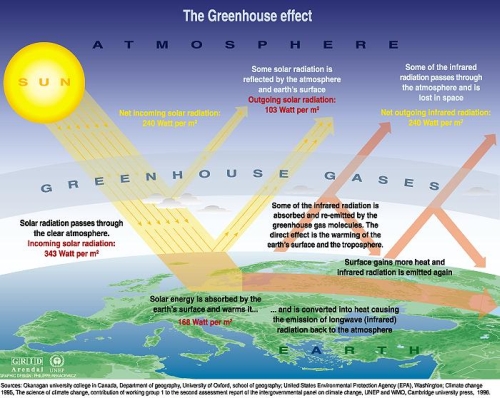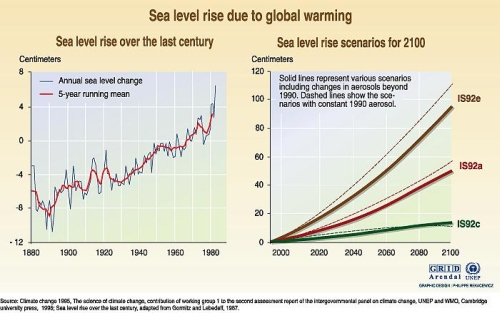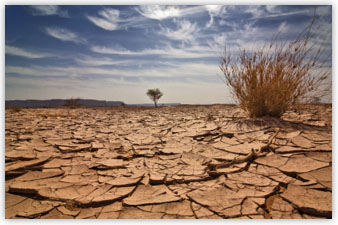CLIMATE CHANGE
The Greenhouse Effect and the Carbon Cycle
Source: www.unfccc.int
Too much of a good thing
Life on earth is made possible by energy from the sun, which arrives mainly in the form of visible light. About 30 per cent of sunlight is scattered back into space by the outer atmosphere, but the rest reaches the earth's surface, which reflects it in the form of a calmer, more slow-moving type of energy called infrared radiation. (This is the sort of heat thrown off by an electric grill before the bars begin to grow red.) Infrared radiation is carried slowly aloft by air currents, and its eventual escape into space is delayed bygreenhouse gases such as water vapour, carbon dioxide, ozone, and methane.
Greenhouse gases make up only about 1 per cent of the atmosphere, but they act like a blanket around the earth, or like the glass roof of a greenhouse - they trap heat and keep the planet some 30 degrees C warmer than it would be otherwise.
Human activities are making the blanket "thicker" - the natural levels of these gases are being supplemented by emissions of carbon dioxide from the burning of coal, oil, and natural gas; by additional methane and nitrous oxide produced by farming activities and changes in land use; and by several long-lived industrial gases that do not occur naturally.
These changes are happening at unprecedented speed. If emissions continue to grow at current rates, it is almost certain that atmospheric levels of carbon dioxide will double from pre-industrial levels during the 21st century. It is possible they will triple.
The result, known as the "enhanced greenhouse effect," is a warming of the earth's surface and lower atmosphere. The IPCC assesses with very high confidence that the globally averaged net effect of human activities since 1750 has been one of warming. The ‘best case’ computer climate models estimate that the average global temperature will rise by 1.8° C to 4.0° C by the year 2100. A temperature increase of 0.74° C occurred last century and for the next two decades, a warming of about 0.2° C per decade is projected should greenhouse gas emissions continue to rise at their current pace and are allowed to double from their pre-industrial level.
A rise in temperature will be accompanied by changes in climate - in such things as cloud cover, precipitation, wind patterns, and the duration of seasons. In its Fourth Assessment Report, the IPCC projects that heat waves and heavy precipitation events are very likely to increase in frequency in the 21st century. In a world that is crowded and under stress, millions of people depend on weather patterns, such as monsoon rains, to continue as they have in the past. Changes, at a minimum, will be difficult and disruptive.
Carbon dioxide is responsible for over 60 per cent of the "enhanced greenhouse effect." Humans are burning coal, oil, and natural gas at a rate that is much, much faster than the speed at which these fossil fuels were created. This is releasing the carbon stored in the fuels into the atmosphere and upsetting the carbon cycle, the millennia-old, precisely balanced system by which carbon is exchanged between the air, the oceans, and land vegetation. Currently, atmospheric levels of carbon dioxide are rising by over 10 per cent every 20 years.
Climate change is inevitable because of past and current emissions. The climate does not respond immediately to external changes, but after 150 years of industrialization, global warming has momentum, and it will continue to affect the earth's natural systems for hundreds of years even if greenhouse gas emissions are reduced and atmospheric levels stop rising.
Current Evidence of Climate Change
Extra-strength weather
Numerous long-term changes in the climate have been observed, including extreme weather such as droughts, heavy precipitation, heat waves and the intensity of tropical cyclones.
Trends towards more powerful storms and hotter, longer dry periods have been observed and are assessed in the IPCC’s Fourth Assessment Report. Warmer temperatures mean greater evaporation, and a warmer atmosphere is able to hold more moisture - hence there is more water aloft that can fall as precipitation. Similarly, dry regions are apt to lose still more moisture if the weather is hotter; this exacerbates droughts and desertification.

Droughts are becoming more severe as world temperatures increase.
The frequency of heavy precipitation events has increased over most land areas. Significantly increased precipitation has been observed in eastern parts of North and South America, northern Europe and northern and central Asia. There is also observational evidence for an increase of intense tropical cyclone activity in the North Atlantic since about 1970.
Drying has also been observed over large regions, i.e. the Sahel, the Mediterranean, southern Africa and parts of southern Asia.
In Africa's large catchment basins of Niger, Lake Chad, and Senegal, total available water has decreased by 40 to 60 per cent, and desertification has been worsened by lower average annual rainfall, runoff, and soil moisture, especially in southern, northern, and western Africa.
The Rhine floods of 1996 and 1997, the Chinese floods of 1998, the East European floods of 1998 and 2002, the Mozambique and European floods of 2000, and the monsoon-based flooding of 2004 in Bangladesh (which left 60 per cent of the country under water), are examples of more powerful storms.
The decline of winter

Glaciers retreated significantly during the 20th century.
Average Arctic temperatures increased at almost twice the global rate in the past 100 years. Temperatures at the top of the permafrost layer have generally increased since the 1980s by up to 3°C. In the Russian Arctic, buildings are collapsing because permafrost under their foundations has melted.
Snow cover has declined by some 10 per cent in the mid- and high latitudes of the Northern Hemisphere since the late 1960s. Mountain glaciers and snow cover have declined in both hemispheres and widespread decreases in glaciers and ice caps have contributed to sea level rise. New data evaluated by the IPCC shows that losses from the ice sheets of Greenland and Antarctica have very likely contributed to sea level rise from 1993 to 2003. The average global sea level rose at an average rate of 1.8 mm per year between 1961 and 2003, but between 1993 and 2003 it rose by 3.1 mm per year.
Almost all mountain glaciers in non-polar regions retreated during the 20th century. The overall volume of glaciers in Switzerland decreased by two-thirds.
Shifts in the natural world
Scientists have observed climate-induced changes in at least 420 physical processes and biological species or communities.
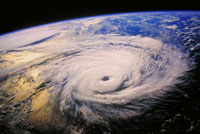
As computer models predict, severe storms are occurring more frequently.
In the Alps, some plant species have been migrating upward by one to four meters per decade, and some plants previously found only on mountaintops have disappeared.
In Europe, mating and egg-laying of some bird species has occurred earlier in the season - in the United Kingdom, for example, egg-laying by 20 of 65 species, including long-distance migrants, advanced by an average of eight days between 1971 and 1995.
Across Europe, the growing season in controlled, mixed-species gardens lengthened by 10.8 days from 1959 to 1993. Butterflies, dragnonflies, moths, beetles, and other insects are now living at higher latitudes and altitudes, where previously it was too cold to survive.
Future Effects
A question of degree
Even the minimum predicted shifts in climate for the 21st century are likely to be significant and disruptive. Scientific understanding and computer models have improved recently and many projections can now be made with greater certainty.
The matter is serious. Predictions of future climate impacts show that the consequences could vary from disruptive to catastrophic.
The minimum warming forecast for the next 100 years is more than twice the 0.6° C increase that has occurred since 1900. . . and that earlier increase is already having marked consequences.
Extreme weather events are striking more often and sea levels have already risen by 10 to 20 cm over pre-industrial averages. Sea level rise will continue for centuries due to the time scales associated with climate processes and feedbacks. In its Fourth Assessment Report, the IPCC states that the contraction of the Greenland ice sheet is projected to continue to contribute to sea level rise after 2100. If this contraction is sustained for centuries, that would lead to the virtually complete elimination of the Greenland ice sheet and a resulting contribution to sea level rise of about 7m.
Projections also point to continued snow cover contraction, as well as widespread increases in thaw depth over most permafrost regions.
A future of more severe storms and floods along the world's increasingly crowded coastlines is likely, and will be a bad combination even under the minimum scenarios forecast. Furthermore, extra-tropical storm tracks are projected to move poleward, with consequent changes in wind, precipitation, and temperature patterns, continuing the pattern observed over the last half century.
The IPCC also points to very likely increases in the amounts of precipitation in high latitudes, as well as likely precipitation decreases in most sub-tropical land regions.
Although regional and local effects may differ widely, a general reduction is expected in potential crop yields in most tropical and sub-tropical regions. Mid-contintental areas - such as the United States' "grain belt" and vast areas of Asia - are likely to dry. Where dryland agriculture relies solely on rain, as in sub-Saharan Africa, yields would decrease dramatically even with minimal increases in temperature. Such changes could cause disruptions in food supply in a world is already afflicted with food shortages and famines.
Salt-water intrusion from rising sea levels will reduce the quality and quantity of freshwater supplies. This is a major concern, since billions of people already lack access to freshwater. Higher ocean levels already are contaminating underground water sources in Israel and Thailand, in various small island states in the Pacific and Indian Oceans and the Caribbean Sea, and in some of the world's most productive deltas, such as China's Yangtze Delta and Vietnam's Mekong Delta.
Most of the world's endangered species - some 25 per cent of mammals and 12 per cent of birds - may become extinct over the next few decades as warmer conditions alter the forests, wetlands, and rangelands they depend on, and human development blocks them from migrating elsewhere.
Higher temperatures are expected to expand the range of some dangerous "vector-borne" diseases, such as malaria, which already kills 1 million people annually, most of them children.
A world under stress
Environmental damage - such as overgrazed rangeland, deforested mountainsides, and denuded agricultural soils - means that nature will be more vulnerable than previously to changes in climate. In any case, when climate shifts occurred thousands and tens of thousands of years ago, they generally took place more gradually. Natural systems had both more space and more time to adapt.
Similarly, the world's vast human population, much of it poor, is vulnerable to climate stress. Millions live in dangerous places - on floodplains or in shantytowns on exposed hillsides around the enormous cities of the developing world. Often there is nowhere else for them to go. In the distant past, man and his ancestors migrated in response to changes in habitat. There will be much less room for migration this time around.
Global warming almost certainly will be unfair. The industrialized countries of North America and Western Europe, along with a few other states, such as Japan, are responsible for the vast bulk of past and current greenhouse-gas emissions. These emissions are a debt unwittingly incurred for the high standards of living enjoyed by a minority of the world's population. Yet those to suffer most from climate change will be in the developing world. They have fewer resources for coping with storms, with floods, with droughts, with disease outbreaks, and with disruptions to food and water supplies. They are eager for economic development themselves, but may find that this already difficult process has become more difficult because of climate change. The poorer nations of the world have done almost nothing to cause global warming yet are most exposed to its effects.
What Can Be Done?
1. Reducing Greenhouse Gas Emissions
Making efficiency pay off
Getting more electricity, transport, and industrial output for less coal, oil, or gasoline is a no-lose situation: more profit, less pollution, less global warming. . . although initial outlays for better equipment and technology can be expensive.
Most of the immediate progress that can be made to reduce greenhouse-gas emissions involves using fossil fuels more efficiently. The savings realized this way will buy time for the global climate system while alternative-energy technologies can be developed and made cost-effective. It is hoped that emissions-free sources ultimately will replace fossil fuels as the main category of energy supply.
"Combined-cycle" turbines - in which the heat from burning fuel drives steam turbines while the thermal expansion of the exhaust gases drives gas turbines -- can boost the efficiency of electricity generation by 70 per cent. In the longer term, new technologies could double the efficiency of power plants.
Gasoline fuel cells and other advanced automotive technologies can cut carbon-dioxide emissions from transport roughly in half, as can "hybrid" gas/electricity vehicles, some of which are already on the market.
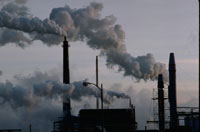
Cutting fossil fuel use while maintaining economic growth will be a major challenge.
Natural gas releases less carbon dioxide per unit of energy than coal or oil. Hence, switching to natural gas is a quick way to cut emissions.
Industry, which accounts for over 40 per cent of global carbon-dioxide emissions, can benefit from combined heat and power co-generation, other uses of waste heat, improved energy management, and more efficient manufacturing processes.
Installing more efficient lighting and appliances in buildings can significantly cut electricity use. Improving building insulation can greatly reduce the amount of fuel needed for heating or air conditioning.
Taking advantage of existing renewable energy technologies
Solar energy and wind-generated electricity - at current levels of efficiency and cost - can replace some fossil-fuel use, and are increasingly being used. Greater employment of such technologics can increase their efficiences of scale and lower their costs. The current contribution of such energy-producing methods to world supplies is less than 2 per cent.
Expansion of hydro-electric power, where appropriate, could make a major contribution to lowering greenhouse-gas emissions. . . but the use of hydropower is necessarily limited by its impacts on human settlements and river systems.
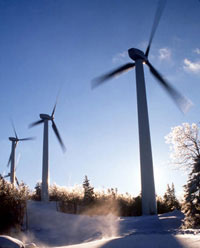
Wind turbines may partially replace fuel-powered electricity generation.
Biomass sources of energy - such as fuelwood, alcohol fermented from sugar, combustible oils extracted from soybeans, and methane gas emitted by waste dumps - can help cut greenhouse gas emissions, but only if vegetation used for the purpose is replaced by equal amounts of replanted vegetation (so that the carbon dioxide released by biomass combustion is recaptured through photosynthesis).
Nuclear energy produces virtually no greenhouse gases, but public concern over safety, transport and disposal of radioactive wastes -- not to mention weapons proliferation - means that the responsible employment of nuclear power will likely remain limited. It now accounts for about 6.8 per cent of global energy supplies.
New technologies have become available for "capturing" the carbon dioxide emitted by fossil-fuel power plants before it reaches the atmosphere. The carbon dioxide is then stored underground in empty oil or gas reservoirs, unused coal beds, or in the deep ocean. While not exactly "renewable," this approach, which is already in limited use, is being scrutinized for possible risks and e
2. Expanding Forests
The role of "sinks"

Forests are a major ally in combating global warming.
Trees and other green plants, using only sunlight for energy, take carbon dioxide out of the atmosphere, releasing oxygen and storing carbon in a safe and useful way. (Any skeptic of the potential of solar power needs only to look at the near-miracle of photosynthesis.) Forests, which provide all kinds of undervalued benefits for mankind, can be major allies in the battle against climate change and global warming. . . if only humans start planting them and stop cutting them down.
The unglamorous term "sinks" is the term used by climatologists for vast swaths of trees and other green vegetation which "drain away" the most dominant greenhouse gas.
Deforestation, which is occurring all over the world, has a doubly damaging effect: it reduces the number of trees that can recover the carbon dioxide produced by human activities, and it releases into the atmosphere the carbon contained in the trees that are cut down.
The world at large currently doesn't "pay" much for the positive effects of forests. The value of trees as lumber and as firewood, and the value of the land they occupy for housing or farming, tend to be short-term and specific. In fact, these benefits may be a matter of survival in some regions. The value of forests for preventing global warming and preserving the earth's biodiversity, by contrast, are long-term and their rewards apply to everyone generally. A way has to be found to make the expansion and nurturing of forests appealing and cost-effective to the local populations that usually decide their fate.
In terms of efforts to reduce global warming, a forest in one place is as good as a forest in another. That can give rise to certain practical arrangements and efficiencies. Under the Kyoto Protocol, once it takes effect, industrialized countries which lack space or cost-effective options for expanding forests on their own territories may partially compensate for their greenhouse-gas emissions by paying for the establishment and maintenance of forests in other countries.
Changing agricultural methods
Carbon stored in agricultural soils often can be preserved or enhanced by switching to "no-tillage" or "low-tillage" techniques, which slow the rate at which organic soil matter decomposes.
In rice fields, emissions of methane, a powerful greenhouse gas, can be suppressed to some extent through tillage practices, water management, and crop rotation.
Using nitrogen fertilizers more efficiently can reduce emissions of nitrous oxide, another potent greenhouse gas.
3. Changing Lifestyles and Rules
The role of culture and habit
People don't necessarily make decisions based on efficiency or the health of the environment. They are apt to do what they've done in the past, what is expected, what their friends and neighbors do, what is fashionable. Driving a car with a large engine when a small engine -- which burns less fuel -- will do the job is a matter of choice. In choosing cars and electrical appliances and methods for heating and cooling their homes, human beings don't necessarily think about climate change. And when thousands and even millions of people make choices that add unnecessarily to the global warming problem, the effects can be considerable.

Lifestyles featuring heavy automobile use contribute significantly to global warming.
Traditions and habits also may limit the lifestyle choices that are available. Businesses and governments tend not to supply products, services, and policies people don't want. Mass transit is much less wasteful of fossil fuels than automobile use, but if the public hasn't demanded mass transit and the necessary train lines and subway systems and bus routes haven't been built, then they aren't quickly available when and if people change their minds. Momentum has to be built up for such changes . . . and yet, paradoxically, if the options aren't available, it's hard to establish momentum for them. "Hybrid" cars use roughly half the gasoline of standard automobiles, but because few customers have asked for such vehicles, the price per car is high and few auto makers produce them.
Lack of demand also slows innovation and technological progress, while heightened interest accelerates it. The key here is "interest." If customers and citizens, especially in industrialized countries, become strongly interested in combating global warming and are willing to buy products that cut emissions, new processes and technologies could well be invented that would greatly reduce or even solve the problem. Enormous technological breakthroughs in the past have occurred because of such pressures.
Governments as prods and guides
Laws and regulations can have a major impact on greenhouse-gas emissions because they affect business behavior and public habits. Some governments encourage the use of mass transit; some -- through tax arrangements, road-building programmes, and even subsidies -- encourage the burning of fossil fuels. One way (admittedly not always popular) of changing behavior is to make it illegal. Another is to make it more expensive through taxes or penalties.
Some governments, spurred by membership in the United Nations Framework Convention on Climate Change, have already attempted to cut greenhouse gas emissions with a mixture of carrots and sticks -- with inducements, subsidies, voluntary programmes, regulations, and fines. Several have attacked the problem directly by imposing "taxes" on carbon use. Others have established "carbon markets" where units of energy use may be bought and sold. These arrangements anticipate provisions that will apply to governments that have ratified the Kyoto Protocol, once the Protocol enters into force.
Minimum standards for energy efficiency in new buildings were updated recently in a series of countries, including Austria, France, Japan, New Zealand, and the United Kingdom. Such measures can include requirements for walls and roofs that limit heat loss. And they can require a minimum level of thermal efficiency for furnaces and water heaters.
Standards for energy efficiency in electrical appliances have been established by some governments. A programme begun by Japan in 1998 is expected to cut the energy requirements of home video recorders by 59 per cent, refrigerators by 30 per cent, and computers by 83 per cent. The sting of more stringent regulations can be softened by inducements, as in the Netherlands, where tougher European Community appliance standards are now in effect. In the Netherlands, householders are entitled to a partial rebate on the purchase prices of the most efficient appliances.
Economic and fiscal instruments have been used to spur shifts in freight transport from roads to rail systems and ships, which use less fuel per ton of goods transported. Examples are the introduction of road tolls in Austria and mileage-based tolls for lorries in Austria, Germany, and Slovenia; increased investments in rail systems in Austria and Belgium; and promotion of ship and rail use for freight in Belgium, Switzerland, and Japan.
Among voluntary arrangements is an agreement reached between the European Union and European and Asian automobile manufacturer organizations setting reduced targets for carbon-dioxide emissions from passenger cars and light commercial vehicles.
"Green tariffs" have been used by Belgium, Germany, Hungary and Switzerland to spur the use of renewable energy. The "tariffs" guarantee electrical-generating companies a higher price for a unit of renewable energy than the prevailing market price.
Steps have been taken by a number of governments to require waste firms and landfills to prevent the escape of greenhouse gases such as methane. Landfill taxes per ton of waste in Switzerland and Norway are higher for facilties that are not sealed. In Austria, taxes are higher for landfills that do not recover the methane emitted.
4. Coping
Adaptation and planning are needed
Since major effects from climate change now appear inevitable, it is vital for countries and communities to take practical steps to protect themselves from the likely disruption and damage that will result. This is known in international jargon as adaptation. In some cases, it's hard to know what to do -- how do you stop encroaching oceans? -- and so strategies and technologies have to be developed. But the greater difficulties are psychological and political.
Prevention calls for overriding human nature and politicians' instincts. It is difficult to take expensive and painful measures when -- in any given place -- people don't know exactly what's coming, exactly when, and how bad it will be. For example, flood walls should be built and in numerous cases it is probably advisable to move human settlements out of flood plains and other low-lying areas, but how high should the walls be and where should people be moved? Even in the case of much more specific threats, it takes brave public officials and stoic populations to act in advance of problems, even though that almost always works better than reacting desperately in times of crises.
Few practical precautions against climate change have been taken to date, although the need is urgent. Efforts are at least going forward in the form of assessments and studies. . . measures that are politically palatable and possible at the moment. One approach that has proven valuable is to focus on vulnerability rather than on the still-uncertain extent of the danger posed by climate change. It is vital, in other words, to know who is going to need help, whatever climate difficulties arise. Further rational decisions can be made and plans developed based on this important information.
A number of countries also are carrying out research. Over the last decade, for example, predictions of the impacts of climate change have grown much more detailed and accurate. As that process advances, and as efficient methods for adapting are devised, it will become more politically and economically feasible to take specific precautions.
In 1997, under the United Nations Framework Convention on Climate Change, new funds were set up to support adaptation. A Special Climate Change Fund was established in 2001 to finance projects relating to adaptation. A Least Developed Countries Fund is intended to enable the world's poorer nations to carry out "national adaptation programmes of action." And an Adaptation Fund was established under the Kyoto Protocol to support the implementation of concrete adaptation projects and programmes.
Flexibility is a valuable tool. It is a sensible way of planning ahead in the agricultural sector, for example, to grow a variety of crops, some of which may be viable in times of climate flux, rather than investing in a single crop that may be felled by a drought or a heat wave. It is useful to determine which crops will be profitable and will grow well in warmer temperatures or a drier climate, if that is what is predicted for a given region. The European Union has encouraged farmers to practice flexibility in land use and crop production. It also has suggested modifying subsidy and incentive programmes to influence farm operation and management in ways that will better cope with climate change.
Rational decisions about the safe location of new facilities and infrastructure is a valuable, cost-effective step governments and industries can take now and in coming years. It is better to put future electrical-generating plants, train lines, major roads, and hospitals, not to mention houses, in spots where more intense storms and floods won't damage or destroy them.
One benefit of the generally difficult process of adaptation is that some measures will have positive effects regardless of what happens with climate change. Restoring tree cover, wetlands, and grasslands to prevent erosion and to lessen damage from storms and floods will help people even when normal storms occur -- and also will provide sanctuary for wildlife and have aesthetic and recreational benefits. Similarly, setting up evacuation plans and medical response systems for severe storms and floods can save lives when and if other catastrophes strike.
The United Nations Framework Convention on Climate Change
The Convention on Climate Change sets an overall framework for intergovernmental efforts to tackle the challenge posed by climate change. It recognizes that the climate system is a shared resource whose stability can be affected by industrial and other emissions of carbon dioxide and other greenhouse gases. The Convention enjoys near universal membership, with 192 countries having ratified.
Under the Convention, governments:
- gather and share information on greenhouse gas emissions, national policies and best practices
- launch national strategies for addressing greenhouse gas emissions and adapting to expected impacts, including the provision of financial and technological support to developing countries
- cooperate in preparing for adaptation to the impacts of climate change
The Convention entered into force on 21 March 1994.
Kyoto Protocol

Delegates celebrated adoption of the Protocol in 1997.
The Kyoto Protocol is an international agreement linked to the United Nations Framework Convention on Climate Change. The major feature of the Kyoto Protocol is that it sets binding targets for 37 industrialized countries and the European community for reducing greenhouse gas (GHG) emissions .These amount to an average of five per cent against 1990 levels over the five-year period 2008-2012.
The major distinction between the Protocol and the Convention is that while the Convention encouraged industrialised countries to stabilize GHG emissions, the Protocol commits them to do so.
Recognizing that developed countries are principally responsible for the current high levels of GHG emissions in the atmosphere as a result of more than 150 years of industrial activity, the Protocol places a heavier burden on developed nations under the principle of “common but differentiated responsibilities.”
The Kyoto Protocol was adopted in Kyoto, Japan, on 11 December 1997 and entered into force on 16 February 2005. 182 Parties of the Convention have ratified its Protocol to date. The detailed rules for the implementation of the Protocol were adopted at COP 7 in Marrakesh in 2001, and are called the “Marrakesh Accords.”
The Kyoto mechanisms
Under the Treaty, countries must meet their targets primarily through national measures. However, the Kyoto Protocol offers them an additional means of meeting their targets by way of three market-based mechanisms. The Kyoto mechanisms are:
- Emissions trading – known as “the carbon market"
- the clean development mechanism (CDM)
- joint implementation (JI).
The mechanisms help stimulate green investment and help Parties meet their emission targets in a cost-effective way.
Monitoring emission targets
Under the Protocol, countries’actual emissions have to be monitored and precise records have to be kept of the trades carried out.
Registry systems track and record transactions by Parties under the mechanisms. The UN Climate Change Secretariat, based in Bonn, Germany, keeps an international transaction log to verify that transactions are consistent with the rules of the Protocol.
Reporting is done by Parties by way of submitting annual emission inventories and national reports under the Protocol at regular intervals.
A compliance system ensures that Parties are meeting their commitments and helps them to meet their commitments if they have problems doing so.
Adaptation
The Kyoto Protocol, like the Convention, is also designed to assist countries in adapting to the adverse effects of climate change. It facilitates the development and deployment of techniques that can help increase resilience to the impacts of climate change.
The Adaptation Fund was established to finance adaptation projects and programmes in developing countries that are Parties to the Kyoto Protocol. The Fund is financed mainly with a share of proceeds from CDM project activities.
The road ahead
The Kyoto Protocol is generally seen as an important first step towards a truly global emission reduction regime that will stabilize GHG emissions, and provides the essential architecture for any future international agreement on climate change.
By the end of the first commitment period of the Kyoto Protocol in 2012, a new international framework needs to have been negotiated and ratified that can deliver the stringent emission reductions the Intergovernmental Panel on Climate Change (IPCC) has clearly indicated are needed.
